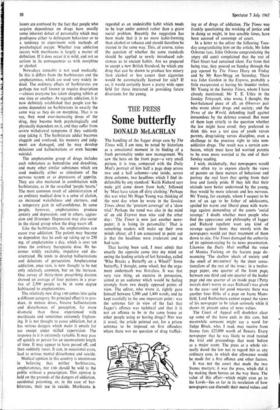Soft answer
MEDICINE JOHN ROWAN WILSON
It is apparent from some of the letters printed in the press during the past week that there is still considerable confusion in the public mind about the significance of the so-called 'soft' drugs. Perhaps this classification itself is an un- fortunate one. The drugs generally included under it—marihuana, the barbiturates, the amphetamines, and LSD—differ widely both in their effects and in their liability to produce addiction.
Marihuana (otherwise known as cannabis indica, Indian hemp, or hashish) is nowadays almost always taken in the form of cigarettes and leads to psychological effects which tend to differ from one individual to another. The com- mon factor is an altered state of consciousness. Thoughts are dreamy and ideas disconnected. The subject may feel happy and exalted but on the other hand he may feel depressed and fearful. Perception is disturbed and hallucina- tions may occur. One of the commonest effects is an altered sensation of time, so that minutes seem like hours and hours like minutes. If the subject is alone he is usually passive and drowsy, but when the drug is taken in company it often leads to restlessness and excitement.
For years people have been arguing, par- ticularly in the United States, about the precise sociological significance of marihuana. In the context of the very serious American drug problem it has usually been regarded as of minor importance. One addiction specialist described it to me contemptuously as 'kid-stuff.' There is disagreement as to whether it pre- disposes to criminal behaviour or to the use of other more dangerous drugs. Both these issues are confused by the fact that people who acquire dependence on drugs have usually some inherent defect of personality which may predispose either to delinquent behaviour or to a tendency to experiment with methods-of
psychological escape. Whether true addiction occurs with marihuana is largely a matter- of definition. If it does occur it is mild, and not so serious in its consequences as with morphine or alcohol.
Nowadays cannabis is not used medically. In this it differs from the barbiturates and the amphetamines, which are used very widely in- deed. The ordinary effects of barbiturates are perhaps too well known to require description —almost everyone has taken sleeping tablets at one time or another. As regards addiction, it is now definitely established that people can be- come dependent on barbiturates in exactly the same way as they do on morphine. That is to say, they need ever-increasing doses of the drug, they become both psychologically and physically dependent on it, and they suffer from severe withdrawal symptoms if they suddenly stop taking it. The barbiturate addict becomes sluggish and confused, his memory and judg- ment are damaged, and he may develop delusions and hallucinations or even become suicidal.
The amphetamine group of drugs includes such substances as benzedrine and dexedrine, and many other similar substances which are used medically either as stimulants of the nervous system or as depressors of appetite. They are also marketed in combination with barbiturates, as in the so-called 'purple hearts.' The most common result of administration of an ordinary medical dose is a sense of elation, an increased wakefulness and alertness, and a temporary gain in self-confidence. In some people, however, amphetamines produce anxiety and depression; and in others, aggres- sion and ill-temper. Depression may also occur in the elated group when the drug wears off.
Like the barbiturates, the amphetamines can cause true addiction. The patient may become so dependent that he ends up taking up to 250 mg. of amphetamine a day, which is over ten times the ordinary therapeutic dose. He be- comes wildly excitable, impulsive and dis- orientated. He tends to develop hallucinations and delusions of persecution. Amphetamine addiction, once rare, is now thought to be not only relatively common, but on the increase. One survey of thirty-three prescribing doctors showed an average of four patients in a prac- tice of 2,500 people to be in some degree habituated to amphetamines.
The relatively new drug LSD comes into quite a different category. Its principal effect is to pro- duce, in minute doses, bizarre hallucinations and disturbances of perception, far more dramatic than those experienced with marihuana and sometimes extremely frighten- ing. It is not thought to cause addiction, but it has serious dangers which make it unsafe for use except under skilled supervision. The response to it is extremely variable. It may pass off quickly or persist for an inconvenient length of time. It may appear to have passed off, and then suddenly recur. It can, in occasional cases, lead to serious mental disturbance and suicide. Medical opinion in this country is unanimous in believing that neither barbiturates,
amphetamines, nor LSD should be sold to the
public without a prescription. This opinion is held on the grounds of the dangers of addiction, accidental poisoning, or, in the case of bar- biturates, their use in suicide. Marihuana is regarded as an undesirable habit which needs to be kept under control rather than a grave social problem. Recently the suggestion has been made that it is no more habit-forming than alcohol or tobacco and should therefore be treated in the same way. This, of course, raises the question of whether the same standards should be applied to newly introduced sub- stances as to ancient habits. Are we prepared to accept a new British Standard, by which any drug that can be shown to produce less misery than alcohol or less cancer than cigarettes would be automatically licensed for sale? If so, it would certainly leave a pretty wide open field for those interested in providing future diversions for the young.







































 Previous page
Previous page